Silver nanoparticles stabilized by a metal–organic framework (MIL-101(Cr)) as an efficient catalyst for imine production from the dehydrogenative coupling of alcohols and amines†
Abstract
In this paper, we present silver nanoparticles supported on a metal–organic framework (Ag@MIL-101) as a catalyst for the one-pot tandem synthesis of imines from alcohols and amines. The Ag@MIL-101 catalyst was fabricated using the liquid phase impregnation technique as an easy and effective method. The morphology and chemical structure of the prepared catalyst were systemically evaluated by inductively coupled plasma optical emission spectroscopy (ICP-OES), powder X-ray diffraction (P-XRD), X-ray photoelectron spectroscopy (XPS) and transmission electron microscopy (TEM). The highly crystalline feature of the Ag metal nanoparticles on bifunctional MIL-101(Cr) was revealed by TEM and HRTEM analyses. The Ag@MIL-101 catalyst was examined as a catalyst for the synthesis of different imine derivatives. The catalytic performance of the Ag@MIL-101 catalyst was monitored by GC-MS and 1H-NMR analyses for the dehydrogenative coupling of alcohols and amines. Furthermore, the effect of various factors such as the amount of catalyst, base, temperature and solvent was investigated to optimize the conditions for the best performance of the Ag@MIL-101 catalyst. Catalytic activity test results showed that the Ag@MIL-101 catalyst has a good catalytic activity with TOF values in the range of 12.7–14.6 h−1 in the synthesis of various imines.



 Please wait while we load your content...
Please wait while we load your content...